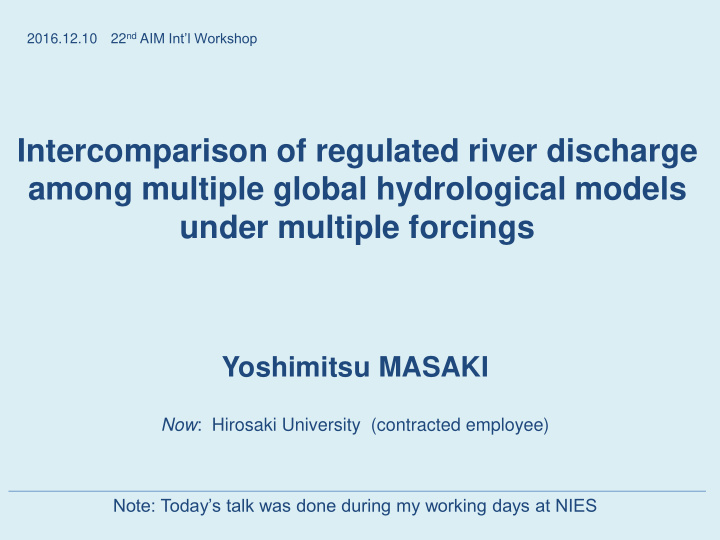



22 nd AIM Int’l Workshop 2016.12.10 Intercomparison of regulated river discharge among multiple global hydrological models under multiple forcings Yoshimitsu MASAKI Now : Hirosaki University (contracted employee) Note: Today’s talk was done during my working days at NIES
1. Introduction
Introduction • Dams (>60000 in the world) – Most large rivers are regulated = We cannot neglect dam effects – No intercomparison on flow regulation has been performed • Aims of this paper We examined the characteristics of river discharge regulated by dams using multiple global hydrological models (GHMs) under multiple meteorological forcings Two-parted papers were written with co-authors: • Paper I (multiple forcings) Masaki, Y., N. Hanasaki, K. Takahashi and Y. Hijioka • Paper II (multiple models) [ this talk ] Masaki, Y., N. Hanasaki, H. Biemans (LPJmL) , H. Müller Schmied (WaterGAP) , Q. Tang (DBH) , Y. Wada (PCR-GLOBWB) , S. N. Gosling (GHM-Coordinator) , K. Takahashi and Y. Hijioka
ISI-MIP • This study was done in the framework of ISI-MIP 2a – ISI-MIP: Inter-Sectoral Impact Model Intercomparison Project – Headed by PIK (Potsdam Institute for Climate Impact Research, Germany) – ISI-MIP2a: Validation for impact analysis – See details: https://www.isimip.org/ Phase Main tasks & target outcomes (IPCC reports) Future climate change impacts using CMIP5 (using 5GCMs × 4RCPs) Fast track (finished) IPCC AR5 2a Historical validation (including extreme events) [ Today’s talk ] (finished) Future climate change impacts, esp. in terms of “1.5 degree target” 2b (now-2017?) +land-use change + projection till 2300 IPCC Special Report on 1.5degree target 3 ? (Future climate change impacts at high spatial resolutions using CORDEX)
Intercomparison of impact models • Using common meteorological inputs and settings ISI-MIP Coordinator provides these data sets • Details are defined in the protocol Outputs Impact models Input data e.g.,
2. Methods and Analysis
Method • ISI-MIP2.1A (Water Sector) – Multimodel intercomparison: 5 global hydrological models DBH, H08, LPJmL, PCR-GLOBWB, WaterGAP – Multiforcing intercomparison: 4 meteorological forcings GSWP3, Princeton, WFDEI, WATCH * Today, we’ll mainly talk GSWP3 results – Varsoc runs: Time-varying human interventions (dams, water withdrawal, change in land use) – Nosoc runs: No human interventions – Historical simulations (1971-2000/2010)
Method • Two case-study river basins in US – Missouri-Mississippi and Green-Colorado Rivers – With large dams on the main channel • How to examine dam effects? – We examined change in river discharge at dam sites – Land cells were numbered along the main channel (SCN: sequential cell number) Missouri- Mississippi River Green-Colorado River
River Channels and SCNs Fort Peck Dam (default: SCN 22) Glen Canyon Dam (default: SCN 17)
River Channels and SCNs Fort Peck Dam (SCN 22) Glen Canyon Dam (SCN 17)
3. Results
Seasonal Fraction • Larger discrepancies in seasonality in the upper reach – Snow melt flow is observed in spring to early summer – Discrepancies are attributable to flow regulation, as well as natural flow in each GHMs Fall F: Fort Peck Dam Summer G: Garrison Dam Spring O: Oahe Dam Winter Upper reach Lower reach
Seasonal Fraction • Larger discrepancies in seasonality in the upper reach – Snow melt flow is observed in spring to early summer – Discrepancies are attributable to flow regulation, as well as natural flow in each GHMs Fall Summer C: Glen Canyon Dam Spring H: Hoover Dam Winter Upper reach Lower reach
Seasonal discharge (regulated) • Larger discrepancies Upper in regulated reach seasonal discharge are also seen in upper reaches • If models show good performance at the river mouth, the models do not always perform well in other river Fall streches Lower Summer reach Spring Winter
Changes in hydrograph at dam sites Natural flow (nosoc) Fort Peck Dam on the Missouri River Regulated flow (varsoc)
Changes in hydrograph at dam sites Natural flow (nosoc) Fort Peck Dam on the Missouri River Regulated flow (varsoc) Flow regulation Weak Strong Strong Weak Intermediate
Changes in hydrograph at dam sites Natural flow (nosoc) Glen Canyon Dam on the Colorado River Regulated flow (varsoc)
Changes in hydrograph at dam sites Natural flow (nosoc) Glen Canyon Dam on the Colorado River Regulated flow (varsoc) Strong Flow regulation Weak Strong Strong Weak
Different magnitude of flow regulation among GHMs • Strong regulation – H08, LPJmL, (WaterGAP) • Weak regulation – DBH, PCRglobwb Possible reasons • Differences in inflow without human interferences – reflecting land model characteristics (e.g., runoff) • Differences in dam operation schemes – generally are a function of inflow, requirement and storage – most models adopted Hanasaki et al. (2006)’s scheme • Differences in initial storage (at the beginning of a hydrological year)
Conclusion • The magnitude of dam regulation differs considerably among GHMs – The differences are attributable not only to dam operation schemes but also to the natural inflow to dams • Intermodel discrepancies are less significant toward the lower reach – Intermodel comparison should be made in the upper reach, as well as in the lower reach Problems to be solved for future model comparisons • Dam location – Inconsistency in dam location among GHMs
Thank you for your attention ymasaki@hirosaki-u.ac.jp
Recommend
More recommend